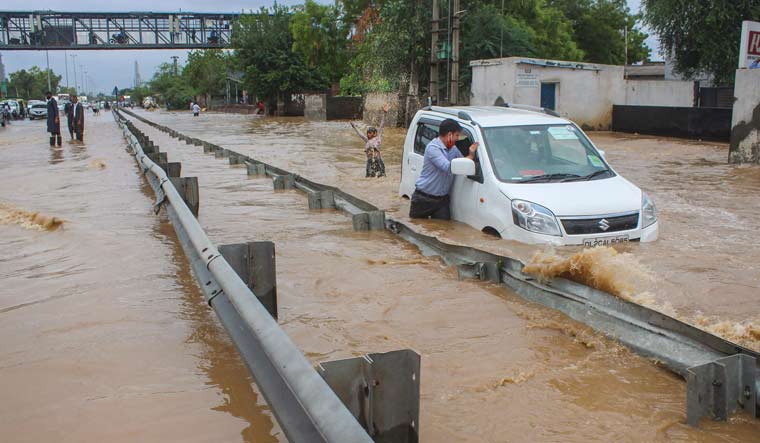Loren Eiseley once remarked, “If there is magic on this planet, it is contained in water.” Water can be a boon or bane, depending on how we managed. As water finds its own path, urban flooding defies the man-made order of cities. The recent surge of urban flooding vividly illustrates the pressing challenges we confront in effectively managing water within cities. The need to address these issues calls for a comprehensive institutional framework that encompasses the financial and social strengthening of our urban centres.
Urbanisation and climate change are transforming our natural landscape, increasing the frequency and intensity of flood incidents. To protect our rivers and reduce the effects of urban floods, we must prioritise sustainable practises in urban development. This highlights the crucial importance of coexisting harmoniously with water and emphasises the need for sustainable urban development practices that can effectively alleviate the consequences of extreme weather events.
Delhi’s tryst with urban floods
Cities like Delhi are grappling with the devastating impacts of urban flooding caused by a combination of factors: unprecedented and extreme rainfall patterns, silt buildup, and encroachment on floodplains, which have collectively increased the city's vulnerability to flooding. The Yamuna river, a lifeline for the city, suffers from reduced carrying capacity due to encroachments, intensifying the effects of heavy rains.
Inadequate urban planning and insufficient infrastructure further exacerbate the problem, leaving low-lying areas dangerously exposed to flood during the monsoon seasons. This highlights the importance of adopting sustainable urban development methods that embrace water-sensitive design and infrastructure.
Reasons for flooding
Unplanned urbanisation has severely impacted the natural drainage systems that once played a crucial role in regulating the water flow. As cities expand unevenly, infrastructure development fails to keep pace, further escalating the risks of flooding. Additionally, the growing concrete jungles, lack of efficient drainage and sanitation systems compound the problem, magnifying the impact of intense rainfall events. This compels us to reassess our urban planning.
Solutions to tackle urban floods
Addressing the challenges posed by urban flooding requires a multifaceted approach. Cities must prioritise sustainable urban planning, comprehensive infrastructure development, and the preservation and restoration of natural water bodies to effectively address urban flooding. Measures such as green roofs, rainwater harvesting systems, and permeable pavements can reduce surface runoff and alleviate pressure on drainage systems. These solutions are crucial in building flood-resilient communities.
Sustainable urban planning involves designing proper drainage systems and implementing effective flood control measures. By regulating construction activities and preventing encroachments on floodplains and riverbeds, cities can minimise the risk of flooding. A city's ability to withstand floods may be significantly increased by making investments in flood-resistant structures, upgrading storm water management systems, and setting up early warning systems.
Nature-based solutions
Nature-based solutions play a vital role in managing flooding. Preserving and restoring wetlands, creating green spaces, and implementing sustainable drainage systems are key components of these solutions. Increasing permeable surfaces and establishing ‘green sponges’ along drains and rivers help to enhance water retention and reduce flood risks. Wetlands and green spaces act as natural buffers, effectively absorbing and storing excess water during heavy rainfall events. In addition to mitigating flooding, these nature-based solutions provide additional benefits such as improving biodiversity, enhancing urban aesthetics, and promoting community well-being.
Technology at the helm
Technological interventions offer valuable tools for flood management. Flood control centres equipped with real-time monitoring systems and hydrodynamic modelling enable accurate prediction of flood events. By leveraging technological advancements, cities can enhance their flood management strategies, minimise damage, and protect lives and property.
Sustainable urban planning & infrastructure development
Planning and infrastructure interventions are also crucial in building flood-resilient communities. Comprehensive land use plans that include flood-resilient design concepts, such as setback zones along rivers and floodplains, can lessen the vulnerability of flood-prone locations. Investing in infrastructure such as underground flood defence systems and storm water drainage increases the city's ability to properly channel and manage surplus water. These actions have significance for improving flood resilience and reducing the effects of urban floods.
By prioritising sustainable urban development practices and integrating flood management strategies into governance frameworks, cities can significantly mitigate flood risks and protect communities.
Effective governance to the rescue
Ensuring sustainable water resource management requires a combination of financial, human, skilling, and regulatory frameworks, as well as individual initiatives. Moreover, raising awareness about the ecological and cultural significance of water bodies can foster a sense of responsibility and encourage community participation in their preservation and protection. Collaboration with government officials and communities is vital for promoting accountability and meeting the requirements of the local community. Strengthening local governance and establishing a single body in charge of flood control streamlines operations and allows for a more prompt response.
Through effective governance, cities can redefine their urban landscapes, implement necessary measures, and create a more resilient future. We can construct cities that are better suited to address the problems posed by urban floods by embracing sustainable governance practises, providing a safer and more sustainable environment for all. Let us seize this opportunity to redesign our cities to be resilient, adaptable, and prepared for future challenges.
Hitesh Vaidya is Director, National Institute of Urban Affairs (NIUA). Manju Rajeev Kanchan is Research Associate and Chidambari Kulkarni is Young Professional at NIUA



